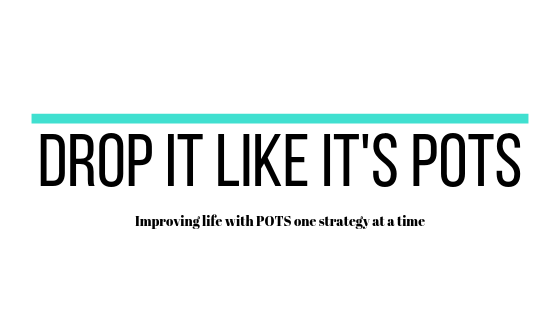I’ve mentioned this in the past, but I like to keep a working list of things I want to try or continue to work on to improve my life with POTS and ME. This practice gives me hope by showing me that I still have options to improve. My list in 2021 looks quite different than it has in the past as it is more about fine-tuning. This is due to the fact that I operate around 70% of my pre-illness function and I have exhausted most treatment options.
Disclaimer- This list applies to my specific set of circumstances and not POTS or ME patients in general.
Manual and Traditional Physical Therapy
During the Dysautonomia International Conference last year, Dr. Rowe mentioned that he recommends manual physical therapy for his patients. It helps the tissues in the body become more balanced and less restrictive which can help with efficiency and fatigue. I am very intrigued to give this a try and plan to get the ball rolling on it in the fall. I would also like to work with traditional physical therapy methods to restore strength to weak areas if I can’t get there on my own.
Movement
I recently read Katy Bowman’s new book called Grow Wild and it has inspired me to continue moving with more frequency and variety as I model this for my kids. Our bodies require frequent and diverse movement (not just exercise) to function properly. To learn more about this concept, check out Katy Bowman’s book Move Your DNA as well as my post about How I Incorporate Natural Movement.
Note- The amount I can move is still limited by fatigue. I cannot function normally for a whole day at this point. So, increasing movement for me includes having more variety in the positions I rest in. Here is an example: rather than sitting in the recliner with my legs tucked up close to me the entire time I rest, I also lay and sit on the floor in various positions.
Nature
I speak about this in my post on the Health Benefits of Spending Time in Nature. I would like to continue to increase the amount of time I spend outside. My next step is to work on eating or preparing food outside.
Perhaps the preparing is a better idea. I don’t know if I could get my husband on board to eat outside. He is a very rational and collected man. However, wasps are his Achilles heel. I have seen this grown man sprint and flail wildly because the shadow of a wasp-sized object passed by him. Each year he schemes up new plots to defeat his wasp foes only for them to be promptly foiled. My favorite was when he duct taped together 3 broom handles to create a mega-stick to knock the wasp nests. He wore a full sweatsuit with the hood up, duct taped ankles and wrists, a mask, and lab goggles. I haven’t been very motivated to solve the wasp problem because it’s just too darn entertaining to watch this carry on. However, if you have any bug and especially wasp-related tips, please share them.

Ditching the sugar
For the most part, I eat a very healthy nutrient-dense diet. However, I would like to do a trial of no added sugar to see how it affects the GI issues I get (primarily bloating with occasional pain). I have done other eliminations that make me suspect that certain amounts of sugar are problematic for me.
Food
As it is said, “Let food by thy medicine, and let medicine by thy food”. Dietary changes have been beneficial for my energy levels, so this is an area I always work to more forward in. I would like to continue to expand the variety and quantity of plants that I eat. I would also like to incorporate more fresh herbs and spices.
Switching up strength training practices
I exclusively did yoga for my strength training for almost a year and sadly it left me with some issues. My knees are prone to getting chondromalacia and they got to the point where I was forced to stop. During that time, I focused on physical therapy exercises and realized that there were some gaping holes in my strength and that yoga was exacerbating my knee issues.
So, I recently switched it up and am doing Mindful Strength. The platform contains workouts from a variety of strength training disciplines and the majority have a calm/controlled vibe (hence the name mindful strength). I find that to work well for my body and nervous system. The workouts are taking my strength to the next level and I am happy with it so far.
Walking
In addition to daily strength or restorative movement practices, I do a daily walk for roughly 30-45 minutes. I think it keeps my muscles feeling better (less gassed) through the day. I want to continue to expand on this and incorporate longer walks on varied terrain.
Weaning off of Mestinon
My neurologist said that she does not see Mestinon being a “forever medication” for me. She recommended that I try to wean off of it when I am in a steady place. Late in May, I went from 30 mg twice per day to 30 mg once per day. A week or two later (early June), I discontinued Mestinon. So far, so good. I don’t feel any worse.
I was nervous to wean off of Mestinon because it was very helpful to me when I began taking it. You may ask then, “Why would you go off of it?”. Over the last year I have gradually walked down the amount of Mestinon I took (I was taking 60mg 3x per day at the highest dosage) because it was causing muscle pain. As I decreased the dosage, I never felt any worse. I stopped at 30mg twice per day because I was no longer getting muscle pain at that dosage. However, I was curious if it was still providing a benefit for me. As I have improved, I have found that I am able to discontinue certain interventions without consequence despite them being useful at the beginning of their use. So, that coupled with my neurologist independently suggesting I try to go sans Mestinon prompted me to give it a whirl. If I find that I need to go back on it down the line, I will have no qualms with that.
What about the stuff in my list from 2020?
- Backing off the exercise– I did this when I finished the Modified Levine Protocol and it was helpful to me to find that right balance where I’m reaping benefits but not burning myself out.
- Acupuncture– I did not try this and I’m not interested anymore. My main interest was in its ability to stimulate the vagus nerve. I tried transcutaneous vagus nerve stimulation at the end of 2020 and did not receive any benefit, so I am less motivated to try this out.
- Chiropractic care– I did not revisit this. I wouldn’t rule this out in the future, but it’s not a high priority right now.
- Functional medicine– I did not revisit this. I’m still cautious about this after my bad experiences a few years ago.
- Para Sym Plus– I did not try this. I would consider trying it in the future, but it’s not at the top of my list.
- Brain rewiring programs– I tried the Gupta Program and it did not help me.
What is on your list of things that you are working on for your health this year?
Note- The Dysautonomia International Conference is coming up in Mid-July! I am ready to get my nerd on and I will share my notes like I did last year. I will most likely stick to the more specific/narrow sessions (vs. the overview sessions). If there are specific sessions you would like me to report back on, drop me a line and I will make sure to cover them.
Disclaimer: I am not a medical professional. Statements on this site are not meant to be taken as medical advice. These statements reflect my personal experiences having mild-ish post-viral POTS and ME. Due to the wide spectrum of these diseases, comorbidities, and everyone being different, your experiences may be very different than mine.
Note: If you post a comment, this site does NOT have a feature to notify you of responses to your comment. I have not found a good solution for that yet. However, I usually respond to every comment in a timely manner, so be sure to check back.






